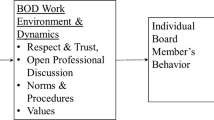Abstract
We argue that Boards of Directors of Danish companieshave been socially constructed as an importantdecision making body in the companies. Since 1974,employees have elected members to the Board ofDirectors. Today they can elect one third of the Boardmembers. In spite of this new composition of theBoard, it has emerged as a team that has been able toconvince the stakeholders, the press, and the publicabout its important standing in the management of thecompany.
To understand this development we look at fourdifferent perspectives. (1) The changing businessenvironment that has framed the development:globalization, mergers and acquisitions, increasedcompetition, technological innovations, strategicalliances, political consumers, and ethical issues are factors that have been the motor for this change. (2)We use a radical social psychological version ofleadership theory (Meindl, 1993) to understand thesocial construction of the change of the role of theBoard of Directors that has occurred. We argue thatthe stakeholders and the society at large haveascribed importance and leadership to the Board, andthat it plays an important role as strategist in thecompanies. (3) We see the board as a theater ensemblestaging a performance for the audience (stakeholdersand the wider environment) using Erving Goffman's``Presentation of Self in Everyday Life'' (1959) as atheoretical point of departure. From this point ofview, the role of the Board is to socialize newmembers, to maintain its unity, and to successfullyplay the role of strategists. (4) To understandstrategists you may understand the company and itsenvironment in either realist terms (objectiveenvironments) or in social constructivist terms(enacted environments) (Smircich and Stubbart, 1985). We adopt the enactment position.
Similar content being viewed by others
References
Baysinger, B. and R.E. Hoskinsson: 1990, "The Composition of Boards of Directors and Strategic Control: Effects on Corporate Strategy", Academy of Management Review 15: 72–87.
Berger, P. and T. Luckmann: 1966, The Social Construction of Reality (N.Y.: Doubleday).
Berle, A.A. and G.C. Means: 1932, The Modern Corporation and Private Property (N.Y.: Macmillan).
Christensen, S. and K. Kreiner: 1991, Projektledelse i løst koblede systemer, ledelse og læring i en ufuldkommen verden (Project Leadership in Loosely Coupled Systems: Leadership and Learning in an Imperfect World) (Copenhagen: Jurist-og Økonomforbundets Forlag).
Christensen, S. and A. Westenholz: 1997, "The Social/Behavioral Construction of Employees as Strategic Actors on Company Boards of Directors", American Behavioral Science 40(4): 490–501.
Christensen, S. and A. Westenholz: 1999a, Medarbejdervalgte i danske virksomheder-fra lønarbejder til borger i virksomhedssamfundet (Elected Employees in Danish Companies: From Wage-Earners to Citizens in the Business Community) (Copenhagen: Copenhagen Business School Press).
Christensen, S. and A. Westenholz, A.: 1999b, The Social Construction of Collective Actors. Paper Presented at the American Sociological Association meeting in Chicago, USA, August.
Christensen, S. and A. Westenholz: 1999c, "Collective Decision Making-Towards a Relational Perspective", American Behavioral Scientist (forthcoming).
Cowen, S. and R. Osborne: 1995, "Bestyrelsen som strategisk redskab (The Board of Directors as a Strategic Tool)", Ledelse I Dag 4: 62–72.
Cyert, R.M. and J.G. March: 1963, A Behavioral Theory of the Firm (Englewood Cliffs, NJ: Prentice Hall).
Demb, A. and F-F. Neubauer: 1992, "The Corporate Board: Confronting the Paradoxes", Long Range Planning 25: 9–20.
Demsetz, H.: 1983, "The Structure of Ownership and the Theory of the Firm", Journal of Law and Economics 26: 375–390.
DiMaggio, P.J. and W.W. Powell: 1983, "The Iron Cage Revisited: Institutional Isomorphism and Collective Rationality in Organizational Fields", American Sociological Review 48: 147–160.
Eisenhardt, K.: 1985, "Control: Organizational and Economic Approaches", Management Science 2: 134–149.
Emirbayer, M.: 1997, "Manifesto for a Relational Sociology", American Journal of Sociology 103(2): 281–317.
Fama, E. and M. Jensen: 1983, "Separation of Ownership and Control", Journal of Law and Economics (June) 26: 301–325.
Forbes, D.P. and F.J. Milliken: 1999, "Cognition and Corporate Governance: Understanding Boards of Directors as Strategic Decision-Making Groups", Academy of Management Review 24(3): 489–505.
Friedland, R. and R.R. Alford: 1991, "Bringing Society Back In: Symbols, Practices, and Institutional Contradictions", in W.W. Powell and P.J. DiMaggio (eds.), The New Institutionalism in Organizational Analysis (Chicago: University of Chicago Press).
Gergen, K.J.: 1994, Realities and Relations-Soundings in Social Constructivism (Cambridge, MA: Harvard University Press).
Goffman, E.: 1959, The Presentation of self in Everyday Life (New York: Doubleday Anchor Books).
Goodstein, J. et al.: 1994, "The Effects on Board Size and Diversity on Strategic Change", Strategic Management Journal 15: 241–250.
Hatch, M.J.: 1997, "Irony and the Social Construction of Contradiction in the Humor of a Management Team", Organization Science (May-June) 8(3): 275–288.
Hill, C. and S. Snell: 1988, "External Control, Corporate Strategy, and Firm Performance in Research-Intensive Industries", Strategic Management Journal 9: 577–590.
Jensen, M.C. and W.C. Meckling: 1976, "Theory of the Firm: Managerial Behavior, Agency Costs, and Ownership Structure", Journal of Financial Analysis 3: 305–360.
Johnson, J., R. Daily and A. Ellstrand: 1996, "Board of Directors: A Review and Research-Agenda", Journal of Management 22: 409–438.
Jonnergård, K. and C. Svensson: 1993, "What Boards Think and How they Behave", Working Paper(Lund University).
Kerr, J.L. and Bettis: 1987, "Boards of Directors, Top Management Compensation, and Shareholder Returns", Academy of Management Journal 30: 645–664.
Langebæk, S.: 1991, Bestyrelsens idegrundlag og funktion (The Idea and Functioning of the Board of Directors) (Copenhagen, Gad).
Lindblom, C.E.: 1959, "The Science of Muddling Through", Public Administrative Review (Spring) XIX.
Lorsch. J.W. and E. MacIver: 1989, Pawns or Potentates: The Reality of America's Corporate Boards(Boston, MA: Harvard Business School Press).
March, J.G.: 1991, "Exploration and Exploitation in Organizational Learning", Organization Science 2: 71–87.
March, J.G. and J.P. Olsen: 1989, Rediscovering Institutions-The Organizational Basis of Politics (New York: The Free Press).
March, J.G. and H.A. Simon: 1958, Organizations (New York: Wiley).
McNulty, T. and A. Pettigrew: 1999, "Strategist on the Board", Organization Studies 20(1): 47–74.
Meindl, James R.: 1993, "Reinventing Leadership: A Radical, Social Psychological Approach", in J.K. Murnighan (ed.), Social Psychology in Organizations. Advances in Theory and Research. (Englewood Cliffs, NJ: Prentice Hall), pp. 89–118.
Meyer, J. and W.R. Scott: 1992, Organizational Environments: Ritual and Rationality, Updated Edition (California: Sage).
Mizruchi, M.: 1983, "Who Controls Whom? An Examination of the Relation Between Management and Boards of Directors in Large American Corporations", Academy of Management Review 8: 426–435.
Nelson, R. and S.G. Winter: 1982, An Evolutionary Theory of Economic Change (Cambridge, MA: The Belknap Press of Harvard University Press).
Oviatt, B.: 1988, "Agency and Transaction Cost Perspectives on the Manager-Shareholder Relationship: Incentives for Congruent Interests", Academy of Management Review 13: 214–225.
Pearce, J. and S. Zahra: 1992, "Board Composition from a Strategic Contingency Perspective", Journal of Management Studies 29.
Pfeffer, J.: 1972, "Size and Composition of Corporate Boards of Directors: The Organization and its Environment", Administrative Science Quarterly 17: 218–229.
Scott, W.R.: 1995, Institutions and Organizations (Thousand Oaks: Sage).
Schulley, J.: 1987, Odyssey-Pepsi to Apple...A Journey of Adventure, Ideas, and the Future (New York: Harper & Row).
Simon, H.A.: 1957, Models of Man (New York: Wiley).
Smircich, L. and C. Stubbart: 1985, "Strategic Management in an Enacted World", Academy of Management Review 10(4): 724–736.
Weick, K.E.: 1993, "Sense-Making in Organizations: Small Structures with Large Consequences", in J.K. Murnighan (ed.), Social Psychology in Organizations. Advances in Theory and Research(Englewood Cliffs, NJ: Prentice Hall).
Weick, K.E.: 1995, Sense-making in Organizations (Thousand Oaks: Sage).
Author information
Authors and Affiliations
Rights and permissions
About this article
Cite this article
Christensen, S., Westenholz, A. Boards of Directors as Strategists in an Enacted World – The Danish Case. Journal of Management & Governance 3, 261–286 (1999). https://doi.org/10.1023/A:1009977806089
Issue Date:
DOI: https://doi.org/10.1023/A:1009977806089




